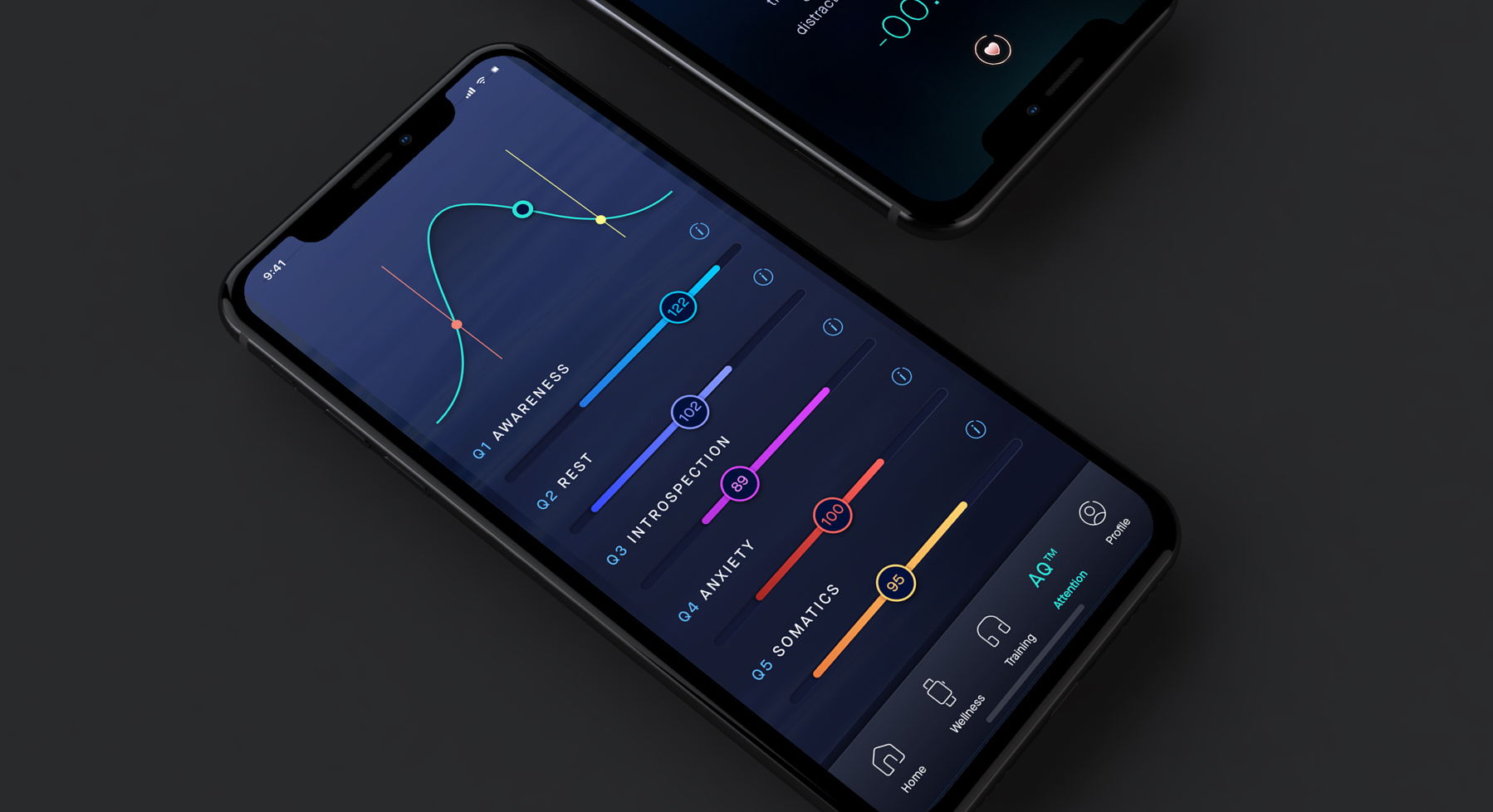As discussed in this blog post, your Attention Quotient™ (AQ™) is made up of five attentional factors. Here we’ll take a deeper dive into each one. As a reminder, your AQ™ is measured by taking a four minutes test within our app and we compare your score against everyone worldwide who’s taken the AQ™ test in order to provide an accurate, unbiased, real-time context to your mental fitness.
Q1: Awareness
Awareness is the perception of a situation. Present moment awareness provides insight into how our actions become our fate. Too often, our lives move along on auto-pilot, and we fall into the same patterns as a passive observer. Through conscious awareness we can become actively engaged in the outcomes of our actions.
The AQ™ App measures your Awareness by measuring your heart rate with your eyes open while you are focused on a single point during the first part of the test.
Q2: Rest
When we close our eyes, our brain is in a state of active rest. This electrical pattern is known as the alpha state. By closing the eyes, the body rests. Our brain’s level of activity when we rest is one of the core processes of sleep. A brain comfortably at rest provides a gateway to quality sleep.
The AQ™ App measures Rest by measuring your heart rate when you close your eyes during the second part of the test.
Q3: Introspection
Introspection is the ability to go inward and be comfortable with the quiet space within. Taking the time to go inward before embarking on an important task can create an environment for success. We are more likely to run little “thought experiments” in which we anticipate possible roadblocks and an ideal outcome when we close our eyes immediately before an action.
The AQ™ App measures Introspection by noting the degree to which your heart rate drops when your eyes are closed during the test.
Q4: Calm
Calm is your ability to maintain inner balance amidst external pressure. In today’s fast-paced environment, we are constantly juggling the demand of work, home, and other areas of life to which we must tend. The better we are at self-regulating our internal state, the more tranquil and at ease we will feel towards what life throws at us.
The AQ™ App measures Calm by analyzing the changes between the eyes open and eyes closed states of the brain. This change allows us to understand when our body is feeling centered and measures the degree of calm we may be experiencing.
Q5: Somatics
Somatics is the awareness of our internal states, what is scientifically known as interoception. As somatic ability grows, a person begins to understand and feel the body from within, including the sensations of the physical body and the emotional and subtle energetic layers within it. As you learn to experience yourself from the inside, you will gain access to direct feedback on the state of your health and wellness. This will bring you closer to the wisdom inherent in your own unique body.
The AQ™ App measures Somatics by utilizing the Heart Beat Detection Task, in which you guess your heart rate with your eyes open. If you do not fill in the answer for this question, your Q5 score will not be available; therefore not included in the overall calculation of your AQ. You can always take the test again and complete this answer to receive a new score.
How is the AQ™ score calculated?
Attention itself is both a trait and state so the measure must be both stable enough to reflect the quality of a personality yet also flexible enough to account for short-term changes such as the influence of sleep and anxiety.
Any Q score, as in IQ (Intelligent Quotient) or EQ (Emotional Quotient), is characterized by two steps:
(1) A within-subjects calculation, and
(2) A between-subjects calculation.
In simple terms, this means we measure a change in your body and then compare your score with others, assuming a normal distribution. In the case of AQ™, we are measuring changes in your heart rate between two different conditions: one with your eyes open (beta state) and the other with your eyes closed (alpha state). These two conditions reflect the basic states of the human brain and the basis of the very first EEG (electroencephalogram). So while we are measuring heart rate, we can make inferences as to what is happening at the level of the brain stem within the brain. In some ways, this data is more telling than an EEG, which is only providing a signal at the outermost (sixth) layer of the cortex. When you close your eyes, your brain switches into a default mode network. This triggers an attentional reflex, what Pavlov called the basic orienting response.
Logic for calculating the AQ™ score:
The five individual measures (and their calculation) of AQ™ are:
(1) Awareness: The less your heart rate wavers during the eyes open state, the stronger your score will be. This reflects the idea that you are able to engage your ability to observe the environment with minimal usage of bodily energy.
(2) Rest: The less your heart rate wavers during the eyes closed state, the stronger your score will be. This is based upon the idea that your heart rate increases its variation as you become deprived of sleep.
(3) Introspection: The more your heart rate drops during the eyes closed state, the greater your inward attentional focus.
(4) Calm: At its core, Calm is the opposite of Anxiety. It reflects the change in heart rate variation between the eyes open and eyes closed states.
(5) Somatics: the closer you are at guessing your heart rate, the higher this score will be.
What’s Next?
This year, Mindwell Labs will be focused on building Sleep Quotient™ (SQ™) as an additional feature within the AQ™ app. Sleep is one of the most important factors in determining your performance and overall quality of life. We believe with the combination of AQ™ and SQ™, we can help you improve your mental fitness in your wake and sleep states.
For general questions, please reach out to hello@theaqapp.com.





